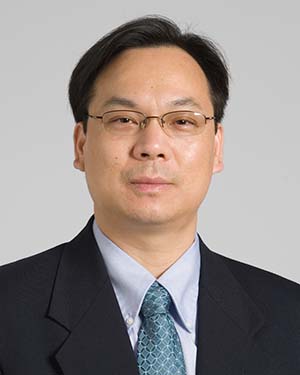Research News
06/30/2020
Targeting WISP1 Shows Early Promise in Treating Glioblastoma in Preclinical Model
Dr. Bao’s team found that WISP1, a key protein in the Wnt/β-catenin-WISP1 signaling pathway, contributes to glioblastoma progression by maintaining glioma stem cells and tumor-associated macrophages, and that blocking the pathway helped control the disease in preclinical models.

Under the direction of Shideng Bao, PhD, who directs the Center for Cancer Stem Cell Research, Lerner Research Institute scientists report in Nature Communications promising findings about a potential new approach for treating glioblastoma, the most common and lethal type of primary brain tumor.
While much progress has been made in recent years to better understand glioblastoma pathology and develop new therapies, patient survival following diagnosis unfortunately remains relatively short. One of the driving forces behind this lethality is the interactions between glioma stem cells (a particularly aggressive subset of cancer cells that can self-renew) and the tumor microenvironment (the non-cancer cell components found within a tumor).
“This cross-talk between tumor-initiating glioma stem cells and other cells found within tumors, including immune cells such as tumor-associated macrophages, contributes to malignancy and has been a major focus of our lab,” said Dr. Bao, who is a staff member in the Department of Cancer Biology and a recognized leader in the field of cancer stem cell biology.
Here, Dr. Bao’s team found that using carnosic acid (a naturally occurring compound found in some plants) to block a specific signaling pathway—called the Wnt/β-catenin-WISP1 signaling pathway, aptly named for the proteins it involves—markedly reduced tumor growth and extended lifespan in a preclinical model of glioblastoma.
“Our study suggests that blocking this signaling cascade may help slow disease by disrupting the maintenance of both glioma stem cells and tumor-supportive macrophages, and by interrupting the pro-cancer cross-talk that happens between glioma stem cells and the tumor microenvironment,” explained Dr. Bao.
The duality of WISP1’s role in glioblastoma
Previous research has shown that Wnt/β-catenin signaling regulates many cell processes, including the progression of several types of cancer. While it has been suggested that this pathway is “turned on” in glioma stem cells and promotes the spread and progression of glioblastoma, how it happens has, to date, not been well understood.
“We found that glioma stem cells secrete a protein called WISP1 (Wnt-induced signaling protein 1).” He expanded, “The increased expression and secretion of WISP1 in glioma stem cells suggested that the protein might play some important roles in driving malignant growth of glioblastoma.”
To test this hypothesis, the researchers disrupted WISP1 expression to observe its effects on tumor growth and progression. They found that genetically silencing WISP1 in their preclinical model inhibited glioma stem cell maintenance and suppressed tumor growth and, surprisingly, that the number of tumor-associated macrophages (TAMs) was reduced.
TAMs are recruited into a tumor by factors secreted by cancer cells. It has been well recognized that the majority of TAMs are tumor-supportive, meaning they contribute to an environment that fosters tumor growth and promotes therapeutic resistance. In addition, most TAMs suppress the anti-cancer efforts of other immune cells. More or less, TAMs are like accomplices that help cancer to grow and spread.
What these findings mean
While these analyses suggested that WISP1 and the related signaling pathway promote the proliferation and self-renewal of glioma stem cells and the survival of tumor-supportive macrophages, Dr. Bao’s team was eager to understand how blocking the pathway by pharmacological inhibition in a preclinical glioblastoma model would actually change the course of disease development.
“We found that blocking the pathway using carnosic acid effectively inhibited tumor growth and significantly increased lifespan in our preclinical model, which we believe to be very promising,” said Dr. Bao.
While this study made use of carnosic acid that penetrates the blood-brain barrier, there are likely other small molecules to target Wnt/β-catenin-WISP1 signaling. Further preclinical and clinical investigations will be important to identify useful drug candidates more effective in slowing or eliminating glioblastoma in patients.
Weiwei Tao, PhD, a postdoctoral research fellow in the Bao lab, is first author on the study, which was supported in part by the National Institute of Neurological Disorders and Stroke (part of the National Institutes of Health).
Featured Experts
News Category
Related News
Research areas
Want To Support Ground-Breaking Research at Cleveland Clinic?
Discover how you can help Cleveland Clinic save lives and continue to lead the transformation of healthcare.
Give to Cleveland Clinic